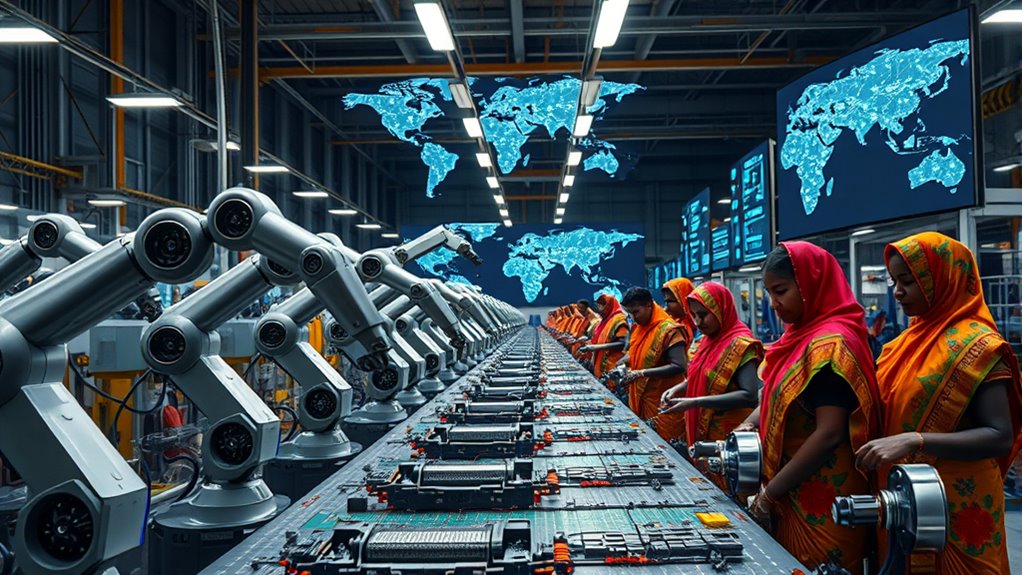Automation can widen existing inequalities in developing countries, as limited infrastructure, skills, and resources hinder their ability to benefit from AI. While automation offers opportunities for growth, it risks displacing low-skilled jobs and deepening economic divides unless strategic investments are made in digital infrastructure, workforce training, and governance. If you want to understand how these challenges can be addressed and what future steps are possible, there’s more to explore below.
Key Takeaways
- Infrastructure deficits and skills gaps limit AI adoption, preventing developing countries from fully benefiting from automation.
- Automation may widen economic inequalities, favoring wealthy nations and deepening the divide with developing countries.
- Limited access to capital and digital infrastructure hampers the deployment of robots and AI solutions in low-income regions.
- Opportunities exist for developing nations to leverage AI for economic growth through targeted investments and local industry integration.
- Effective policies, infrastructure development, and workforce reskilling are critical to ensure automation supports inclusive growth.
Variability of AI’s Impact Across Income Levels

The impact of AI varies considerably across countries with different income levels. In high-income economies, AI can disrupt up to 60% of jobs, often replacing roles or boosting productivity for skilled workers. This can widen income gaps and favor those already advantaged. Emerging markets face about 40% job exposure but struggle with infrastructure and skills, limiting their ability to fully benefit from AI’s potential. Low-income countries have limited AI infrastructure and a deficit of skilled labor, making it difficult to leverage AI for growth. Without proactive policies and international cooperation, these disparities may deepen, increasing global inequality. Developing countries need strategic investments and governance to ensure AI benefits are inclusive, rather than reinforcing existing economic divides. Incorporating natural elements and thoughtful decor can also foster a more welcoming environment for innovation and community development. Additionally, fostering sustainable development practices can help mitigate the environmental impact of AI deployment in these regions. Recognizing the importance of performance tuning and optimizing existing resources can further aid these nations in adapting to technological changes effectively, especially by focusing on technological infrastructure improvements that support AI integration.
Opportunities and Risks in Economic Transformation

Automation offers developing countries the chance to expand their AI markets and boost economic growth, but it also risks widening existing inequalities if access to technology and skills isn’t equitable. Infrastructure and skills gaps pose significant hurdles, potentially limiting the benefits of automation for all. To succeed, you need targeted policies that promote inclusive development and address these challenges head-on. Approximately 880 million people reside in underdeveloped countries, highlighting the vast potential for growth but also the critical need for strategic intervention to ensure benefits are broadly shared. Additionally, understanding the importance of color accuracy and other technological factors can help tailor solutions that maximize the impact of automation in diverse environments. Recognizing the role of local ingredients can also be vital in creating culturally relevant and sustainable automation solutions that resonate with regional markets. Incorporating local ecosystems into planning can further improve the relevance and acceptance of technological advancements, especially when considering the infrastructure that supports digital transformation. Developing digital literacy and ensuring equitable access to technology can significantly enhance the effectiveness of automation initiatives in these regions.
AI Market Expansion Opportunities
As the AI market continues to expand rapidly, developing countries have a unique chance to harness its transformative power for economic growth. The global AI market is projected to grow from $189 billion in 2023 to $4.8 trillion by 2033, with a CAGR of 35.9%. This growth creates significant opportunities in digital transformation, enabling you to modernize infrastructure, improve data collection, and develop AI skills. Affordable, accessible AI technologies, including open-weight models, are making advanced tools more available worldwide. By investing in digital infrastructure, fostering AI literacy, and promoting international cooperation, you can position your country to benefit from AI’s economic potential. Additionally, integrating beauty and grooming technologies into digital platforms can open new markets and consumer segments, further accelerating economic development. Recognizing the importance of digital infrastructure is crucial for supporting these advancements and ensuring equitable access. Building robust digital infrastructure can also facilitate the deployment of home decor innovations that enhance quality of life and consumer engagement. Moreover, leveraging cost-effective solutions like affordable pimple patches can boost local health and beauty industries, creating additional economic opportunities. As new AI-powered tools become more affordable and user-friendly, local businesses can adopt innovative solutions to increase productivity and competitiveness. However, to fully seize these opportunities, strategic planning and inclusive governance are essential to guarantee benefits are widespread. The AI market is expected to represent a 25-fold increase over a decade, which underscores the importance of proactive engagement in AI development.
Inequality Amplification Risks
While automation offers significant growth opportunities, it also risks widening economic disparities between developing and advanced countries. You need to understand that automation benefits rich economies more, as they can substitute labor with robots efficiently. This reduces demand for workers in developing regions, heightening unemployment risks. Additionally, automation-driven productivity boosts in wealthy countries can suppress their exports, damaging developing economies reliant on labor-intensive goods. The risks include:
- Concentration of job losses in low-skill, routine sectors, leaving large, vulnerable workforces behind.
- Limited access to automation capital, slowing industrial growth and deepening regional inequalities.
- Skill gaps widen as education systems struggle to adapt, leaving marginalized populations unprepared for new job markets.
- Digital infrastructure deficits in many developing countries further hinder their ability to adopt and benefit from automation technologies, and the lack of robust technological ecosystems compounds these challenges. Moreover, limited access to automation technology can prevent these nations from capitalizing on productivity improvements, further entrenching economic divides.
These factors threaten to entrench global inequality and hinder developing countries’ economic progress.
Infrastructure and Skills Gaps
Have developing countries truly prepared their infrastructure and workforce to harness AI’s full potential? Many haven’t. Less than a third have AI strategies, limiting their ability to adopt new technologies effectively. Digital infrastructure remains underdeveloped, with poor internet connectivity and insufficient data management systems hampering AI deployment. Energy and resource constraints further restrict AI operations. Skills gaps are also critical; workers often lack the training needed to manage and maintain AI systems. Education and reskilling programs are essential, yet many countries face brain drain and gender disparities that worsen these issues. Without investing in infrastructure and workforce development, these nations risk falling further behind, missing out on AI-driven productivity gains, innovation, and socio-economic improvements that could transform their economies. Limited policy frameworks hinder strategic AI integration and long-term planning. Moreover, investing in technical training and fostering local innovation ecosystems are crucial steps toward bridging these gaps. Expanding digital infrastructure is fundamental for broader AI adoption and economic progression. Additionally, addressing skills development through targeted programs can help mitigate potential job displacement and ensure inclusive growth. Furthermore, understanding the importance of financial investment in these areas is vital for sustainable development. Developing countries must also prioritize comprehensive planning to align AI initiatives with national development goals, ensuring inclusive growth across all sectors.
Sectoral Vulnerabilities and Job Displacement

You should recognize that some sectors in developing countries face higher automation risks, especially those with routine tasks like clerical work and manufacturing. Tasks requiring manual dexterity, creativity, or social skills tend to be less vulnerable to AI and robotics. Understanding these sectoral and task-specific vulnerabilities helps identify where job displacement is most likely to occur. For example, 16PF insights can reveal core personality traits that influence adaptability and resilience in changing work environments.
High-Risk Sectors
Are high-risk sectors in developing countries truly vulnerable to automation and job displacement? While some sectors face risks, others are less affected due to unique factors. For example:
- Manufacturing: Offshoring and foreign investment mean fewer jobs are displaced locally, as robots often complement human operators rather than replace them altogether.
- Agriculture: Heavy manual labor keeps automation at bay, though some tasks—like planting or harvesting—are beginning to automate.
- Construction: Despite increased tech use, automation is limited, maintaining employment levels, though efficiency gains are emerging.
In developing countries, technological lag, informal economies, and trade dynamics further buffer job losses. Still, sectors like transportation and energy are gradually becoming more automated, posing future risks.
Task-Specific Vulnerabilities
While some sectors in developing countries may be less susceptible to automation overall, examining the specific tasks within these industries reveals a more nuanced picture. Tasks like routine data entry or assembly are highly automatable, increasing displacement risks. However, jobs that involve manual dexterity, social interaction, or problem-solving are harder to automate. For example, teaching or healthcare tasks rely on emotional and social skills, lowering their vulnerability. Task diversity within jobs also provides resilience, especially where workers perform both routine and non-routine tasks. Countries with complex task structures, like Armenia, face lower risks. To adapt, workers need reskilling in creative, social, and problem-solving skills. Building local expertise and reducing reliance on foreign tech are essential for sustainable automation integration.
| Task Type | Automation Vulnerability | Resilience Factors |
|---|---|---|
| Routine, predictable tasks | High | Non-routine tasks, social skills |
| Manual dexterity | Low | Adaptability, problem-solving |
| High human interaction | Low | Emotional and social skills |
| Creative or judgment tasks | Low | Complexity, innovation |
Bridging the Digital and Skills Divide in Developing Countries

Bridging the digital and skills divide in developing countries is essential for fostering inclusive growth and ensuring equal opportunities. Without improved access, many are left behind. To address this, focus on these key areas:
Bridging digital and skills gaps is vital for inclusive growth in developing nations.
- Enhancing connectivity by expanding internet infrastructure and reducing costs, making digital services accessible to more people. Improving digital infrastructure is fundamental to this effort.
- Building digital literacy through education programs that teach essential skills, enabling people to participate fully in the digital economy.
- Developing local talent with targeted policies supporting STEM training, fostering a globally competitive digital workforce.
- Investing in Hair Tips to improve overall personal grooming and confidence, which can also positively impact social and economic opportunities.
Challenges in AI Governance and Policy Representation

Effective AI governance in developing countries faces significant hurdles due to limited policy frameworks and resource constraints. You may find that a lack of robust data protection and AI policies increases the risk of misuse and exploitation. Technological dependency on foreign AI creates social risks, including job displacement, while inadequate legal structures hinder regulation and enforcement. You’ll also encounter a shortage of skilled human resources needed to develop local AI solutions tailored to regional needs. Cross-sector collaboration becomes essential, yet difficult to establish. Additionally, policy representation often reflects the interests of the Global North, making it harder for developing countries to shape inclusive, effective regulations. Addressing these challenges requires building local capacity, fostering international cooperation, and developing adaptable, context-specific governance frameworks. Moreover, training programs and educational infrastructure are critical to developing a skilled workforce capable of managing AI technologies effectively. Strengthening local technological infrastructure is also vital to reduce dependency and promote self-sufficiency in AI development, especially considering the importance of creative practice in fostering innovative problem-solving skills essential for adapting to AI-driven changes.
Infrastructure and Technological Barriers to Adoption

You face significant challenges in upgrading digital infrastructure, as unreliable electricity and limited internet access hinder automation efforts. Skill and training gaps further slow adoption, making it difficult to operate and maintain new technologies effectively. Addressing these barriers requires targeted investments in both infrastructure and workforce development.
Digital Infrastructure Gaps
Developing countries face significant digital infrastructure gaps that hinder their ability to adopt new technologies and participate fully in the digital economy. These gaps include limited internet access, outdated network technologies, and unreliable power supplies. Without reliable infrastructure, scaling up digital solutions becomes difficult, trapping these countries behind in global competitiveness.
You should consider that:
- Only 36% of the population in least developed countries use the Internet, far below the global average of 66%.
- High costs, regulatory hurdles, and power issues restrict the deployment of advanced networks like 5G.
- An estimated USD 1.6 trillion investment gap remains to upgrade infrastructure and bridge these disparities.
These barriers prevent developing nations from fully benefiting from technological advancements, slowing their economic growth and integration into the digital revolution.
Skills and Training Deficits
Despite the potential of automation to boost economic growth, many developing countries face significant skills and training deficits that hinder their ability to adopt new technologies. You may find that large portions of the population lack basic literacy and numeracy skills, with around 750 million people unable to read or write. Skill mismatches are common, leaving many workers unprepared for the demands of automated jobs. Economic disengagement is high, especially among youth, due to inadequate skills. Infrastructure limits access to training resources, and technological barriers, like poor digital literacy and weak digital infrastructure, further block adoption. Many institutions lack capacity, and investments in lifelong learning remain minimal. Without targeted skill development, these deficits threaten to slow down automation’s benefits and hinder economic growth.
Social Disparities and Ensuring Inclusive Growth

How can countries with limited resources guarantee that automation promotes inclusive growth rather than deepening social disparities? To do this, you must address key challenges:
- Invest in Human Capital: Focus on education and training to develop a skilled workforce that can work alongside automation.
- Strengthen Social Safety Nets: Implement welfare programs that protect workers displaced by automation and provide support during transitions.
- Encourage Economic Diversification: Reduce dependence on vulnerable sectors by fostering new industries and promoting sustainable growth.
Potential for Innovation and New Industry Creation

Automation has the potential to spark significant innovation and create new industries in developing countries. By boosting efficiency, automation reduces waste and enhances productivity, allowing local tech communities to develop innovative solutions tailored to their needs. It also enables countries to adapt automation technologies to local infrastructure, making solutions more effective. As a result, developing countries can become more competitive in global markets, attracting foreign investment and fostering new industries such as advanced manufacturing and agricultural modernization. Automation encourages the development of technological infrastructure, laying the foundation for sustained growth. While challenges like capital costs and regulatory hurdles exist, automation’s ability to drive innovation offers developing countries a chance to establish emerging industries, create jobs, and improve economic resilience in the long run.
The Role of International Cooperation in AI Development

International cooperation plays a crucial role in advancing AI development because the complexity and resource demands of AI research require collaboration across borders. By working together, you can leverage shared resources, minimize duplicated efforts, and foster responsible AI growth. Here are three key benefits:
- Access to Resources: Sharing data and large-scale computing helps accelerate innovation.
- Talent and Knowledge: Collaboration brings diverse expertise, enriching AI solutions.
- Regulatory Frameworks: Developing common standards promotes ethical AI globally.
These efforts can reduce costs, improve AI quality, and build trust among nations. However, differences in policies, ethics, and geopolitics remain hurdles. Overcoming them is essential to ensure AI benefits are shared worldwide, especially in developing countries.
Strategies for Sustainable AI Integration in Developing Economies

To effectively integrate AI into developing economies, it’s vital to adapt solutions to existing local infrastructure. Use local data sources to ensure relevance and effectiveness, especially when internet connectivity and energy access are limited. Leveraging mobile platforms can expand AI reach where fixed infrastructure is lacking. Incremental upgrades aligned with AI deployment help ensure sustainability and long-term benefits. Focus on building local AI skills through targeted education and training, encouraging homegrown innovation. Collaborate with industry, academia, and government to develop relevant curricula and practical programs. Establish clear regulations and ethical frameworks to foster trust and protect against risks like bias and privacy violations. Promoting inclusive strategies that address marginalized groups, support local languages, and involve communities ensures AI benefits reach everyone, supporting sustainable development.
Frequently Asked Questions
How Can Developing Countries Effectively Regulate AI to Prevent Misuse?
You can effectively regulate AI by establishing dedicated authorities like India’s AI regulatory body, aligning with global standards, and promoting ethical guidelines. Update legal frameworks to prevent misuse, invest in infrastructure, and raise public awareness about AI risks. Engage industries for compliance and implement cybersecurity and data protection measures. International collaboration helps create all-encompassing regulations, ensuring AI benefits society while minimizing harm and fostering trust in AI development.
What Are the Most Cost-Effective Ways to Upgrade AI Infrastructure in Low-Income Regions?
You can upgrade AI infrastructure cost-effectively in low-income regions by leveraging pre-built AI tools and open-source models, which reduce development expenses. Utilizing cloud services offers scalable solutions without heavy upfront investments. Improving hardware efficiency and adopting edge computing cut data transmission and energy costs. Training local talent through educational programs and partnerships builds sustainable capacity, ensuring long-term growth while minimizing expenses. This approach makes AI accessible and beneficial for developing areas.
How Can Developing Countries Ensure AI Benefits Are Equitably Distributed Locally?
Imagine opening AI’s full potential right in your community. To do this, you should craft inclusive policies that prioritize local needs, invest in digital infrastructure, and promote education tailored to AI skills. Encourage local innovation through open tools and affordable solutions. By fostering partnerships and ensuring fair access, you create an environment where AI benefits flow evenly, empowering everyone and building a more equitable, prosperous future for your country.
What Role Should International Organizations Play in Supporting AI Governance?
You should recognize that international organizations play a crucial role in supporting AI governance by fostering global collaboration, establishing ethical standards, and promoting inclusive participation. They facilitate capacity-building, technology transfer, and policy development, ensuring developing countries can participate effectively. By encouraging responsible AI adoption and creating common frameworks, these organizations help manage risks, bridge inequalities, and promote ethical, transparent AI use worldwide, ultimately guiding a balanced, global approach to AI development.
How Can Education Systems Be Adapted to Prepare Workers for Ai-Driven Economies?
You can adapt education systems by emphasizing STEM skills, fostering digital literacy, and promoting lifelong learning. Incorporate AI literacy into curricula, guarantee teachers receive ongoing training, and develop flexible learning platforms that meet diverse needs. Partner with private sectors to create real-world experiences, and involve local communities to tailor approaches. This way, you prepare workers for AI-driven economies and ensure they stay competitive in an evolving job market.
Conclusion
As you navigate this evolving landscape, remember that AI’s promise is like a double-edged sword—capable of forging new horizons or deepening divides. Your choices and actions can be the bridge that transforms potential into progress. By championing inclusive policies and fostering innovation, you hold the power to turn this technological storm into a beacon of hope, ensuring that no country’s rise is stalled, but instead, everyone’s light shines brighter together.









